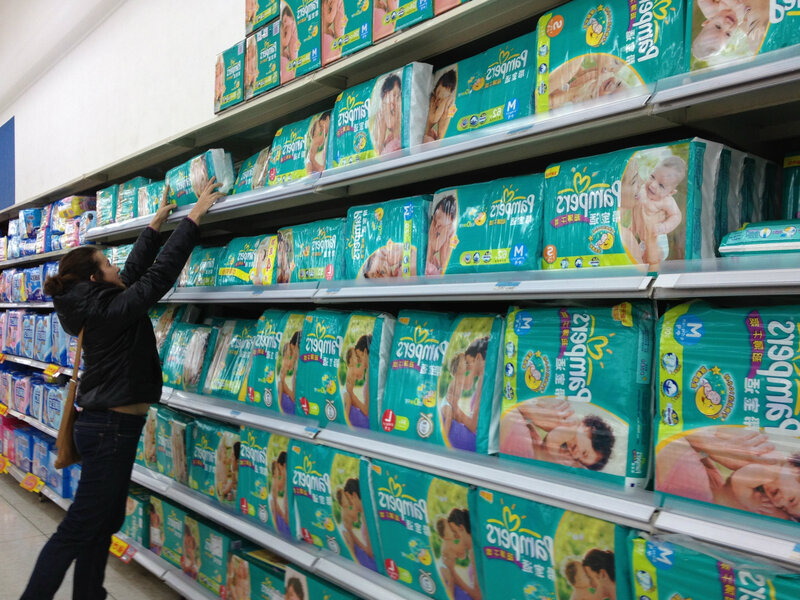Disposable diapers or bare bottoms? China frets over potty training
Loading...
| Beijing
The grandmother and the toddler were huddled in the middle of the sidewalk on Gongtibeilu, not far from Beijing’s Workers Stadium. As the child squatted, a small stream of urine appeared out of a slit in the back of the child’s pants and puddled on the sidewalk while passersby barely gave them a glance. Beaming with pride, the grandmother carefully wiped the tiny bottom, and the two walked off, hand in hand.
The spectacle of babies and children being held over trash cans, squatting in tree boxes, or using the floor of a train as an impromptu toilet is not shocking to anyone who’s lived in China for any length of time. And kaidangku, the split pants that allow this anytime/anywhere release, are as much a sign of China as Chairman Mao’s portrait looming over Tiananmen Square.
But Chinese consumers are rapidly entering the middle class – and it's affecting things as basic as potty training.
Each day, luxury stores like Michael Kors and Alexander Wang open in Beijing, while sales of BMWs and diamonds break records. McKinsey & Company, which tracks consumer spending, estimates that by 2015, China will account for about 20 percent of luxury sales around the globe.
One result is that upwardly mobile Chinese parents are increasingly scorning traditional split pants for their own children as “uncivilized” and loading up on disposable diapers, instead. To many, being wealthy enough to use and toss an item is a sign they’ve arrived.
“Chinese parents in cities have reached the income levels to afford consumer products that provide convenience and facilitate their modern lifestyle,” says Pricie Hanna, a hygiene industry expert with Pennsylvania-based Price Hanna Consultants.
China's potty parity
One young Chinese mother says she sometimes sees children using the sidewalk as a toilet. “Even though I’m a mom, I still hate that kind of behavior,” she says. She and her husband use a combination approach with their 1-year-old: cloth diapers, disposable diapers, and some toilet training.
Diaper companies in China are using the health and hygiene approach to attract parents to disposable diapers, Hanna notes. They are “aggressively educating consumers with messages that high-quality diapers maintain skin dryness and health, and help babies – and their parents – sleep longer at night.”
Pampers – China’s top diaper company – even took that approach one step further, conducting a study in 2006 that reported that babies who used Pampers fell asleep 30 percent faster and slept a half-hour longer at night. That led to its 2007 “golden sleep” campaign, in which Proctor & Gamble asked parents to send in photos of their slumbering babes – all apparently sleeping comfortably in their Pampers – and got 200,000 baby pictures.
Pampers then used that information to target an enormous concern of Chinese parents: linking extra sleep with “improved cognitive performance,” says Pampers spokeswoman Heidi Wang.
Beijing resident Ember Swift, a Canadian woman married to a Chinese man, says that when the couple’s baby was born last winter, she was shocked to learn that her mother-in-law automatically assumed the family would use disposable diapers. “It seems like it’s all about pride,” Ms. Swift says, “and being able to supply a child with expensive disposable diapers. They’ve reached an economic level as middle class where they can afford a partially disposable lifestyle.”
READ MORE on China's rising middle class
That middle class is buying diapers by the millions.
The China National Household Paper Industry Association reported that 2010 sales of diapers in China reached 18.49 billion yuan, or almost $3 billion. Hengan, one of a handful of Chinese diaper manufacturers, reported that its 2011 diaper sales totaled $351 million, a rise of 11.3 percent from the year before. Pampers registered $10 billion in global sales last year, says Ms. Wang, with China coming in as the company’s second-largest market after the United States.
Meanwhile, in the West
Ironically, while Chinese parents are gravitating toward disposable diapers, some Western parents in China are embracing the ancient method of Chinese baby care. In other words, they’re using what’s known as elimination training or elimination communication: training a baby to urinate and defecate on cue when they’re held over a toilet. (See related story on Modern Parenthood.)
Swift, for instance, has become a big advocate of the practice. At first, she had to battle her Chinese mother-in-law. “It’s almost as if I’m the Chinese person,” she says. Nevertheless, as she persisted, her baby eventually got the idea, and now the nine-month-old is well on her way to using the toilet much of the time. Not only does the practice help to prevent diaper rash, Swift says, but it’s far better for the environment.
Though environmentalists worry about the consequences of China adopting a “throwaway consumer lifestyle,” it may be a losing argument. Price Hanna Consultants estimates that China accounts for about 14 percent of all diaper use around the world, but with the second-largest infant population in the world (India has more), it will grow over the next five years to a quarter of the global market.
In fact, Proctor & Gamble announced in 2009 that it had 4 billion customers worldwide. Today the company says it has 4.6 billion and “are confident” about reaching 5 billion by 2015, says spokeswoman Wang. And a large part of the reason for that surge is China.






